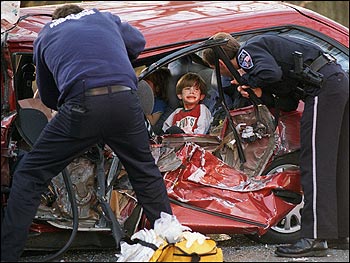Traffic Fatalities and Highest Blood Alcohol Concentration in the Crash, 2002
“More than one-third of all pedestrians 16 years of age or older killed in traffic crashes in 2002 were intoxicated.”
“There were 17,419 alcohol-related fatalities in 2002 — 41 percent of the total traffic fatalities for the year.”
|
Total |
No Alcohol |
Low Alcohol |
|||
|
Number |
% |
Number |
% |
||
| U.S. Total |
42,815 |
25,396 |
59 |
2,401 |
6 |
|
High Alcohol |
Any Alcohol |
||||
|
Number |
% |
Number |
% |
||
| U.S. Total |
42,815 |
15,019 |
35 |
17,419 |
41 |
National Highway Traffic Safety Administration
Seat Belt Usage
 The number of fatalities and serious injuries caused by traffic crashes on US highways is alarming. However, spending one second to fasten a seat belt could make the difference between life and death.
The number of fatalities and serious injuries caused by traffic crashes on US highways is alarming. However, spending one second to fasten a seat belt could make the difference between life and death.
Injuries from traffic crashes are the leading cause of death for people between the ages of one and 42. Each year, more than 40,000 people die on our nation’s highways, and many more are seriously injured. In fact, according to the National Highway Traffic Safety Administration (NHTSA), someone in America is injured in a traffic crash every 14 seconds, and every 12 minutes someone is killed.
The single and most effective protection against death and serious injury in a car crash is the seat belt. Though most people — 73% — say they are full time seat belt users, almost 10% acknowledge that they did not use their belts on at least one occasion during the last week.
A car crash can happen anywhere. Even if you are just running out for a carton of milk, or you know the route like the back of your hand, you and your passengers are still at risk. While it is true that air bags are an effective safety measure, it is important to remember that they are only a supplement for seat belts, not a replacement.
So buckle up. Always. No matter how short the trip. According to NHTSA, most car crashes happen within 25 miles of home. And always make sure that children are properly restrained in child safety seats, and passengers 12 and under ride in the back seat. This is especially crucial in cars that come equipped with front passenger air bags — the impact of an air bag during a crash could kill younger, smaller passengers. It only takes a second, so buckle up.
Older children less likely to wear safety belts, report says
Children age 8 through 15 are less likely to be properly restrained in safety belts, are being placed in the front seat at alarming rates and are facing high fatality rates, a new report found.
“These children are needlessly at risk,” said Philip Haseltine, co-moderator of the 2003 Child Passenger Safety Summit, which issued the report, and president of the Automotive Coalition for Traffic Safety. Haseltine said that while most child passenger safety programs target infants, toddlers and booster-age children, few focus on children who have outgrown booster seats, ranging from pre-teens to those almost old enough to get a driver’s license. “We need to develop effective programs to get older children properly restrained,” he added.
Fewer than 30 percent of infants killed in crashes in 2000 were unrestrained, but more than 70 percent of 12-year-olds killed were not restrained, according to the National Highway Traffic Safety Administration. In addition, a recent observational survey by the National SAFE KIDS Campaign found that restraint use was 97 percent for infants, 92 percent for children ages 1-4, and 83 percent for children ages 5-7, but just 69 percent for children ages 5-15. Child passenger safety experts from industry, government, advocacy and research organizations who participated in the summit, which was held in June, developed several recommendations, including:
–Encouraging public and private sector health and safety organizations to develop research-based safety belt messages and programs for children who have outgrown booster seats but don’t yet have driver’s licenses
–Encouraging the U.S. Department of Health and Human Services, health departments, health care providers and social service agencies to support more programs for underserved populations
–Ensuring that every State child restraint law requires correct restraint use for children in all seating positions in all passenger vehicles and that every child restraint law provides for primary enforcement
–Enacting primary safety belt laws because enforcement tends to increase restraint use by children as well as adults
National Safety Council
